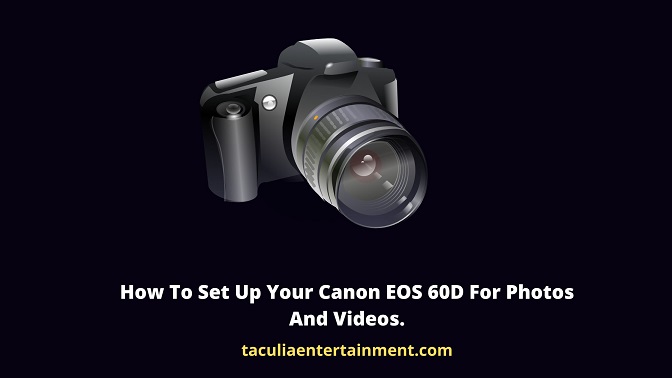
In this article, I am going to show you how to set up your canon EOS 60D camera for both photos and video shoots.
Canon EOS 60D is a DSLR camera that is capable of taking photos and shooting videos.
Depending on how conversant you are with this camera’s settings, you can take great photos and shoot high-quality videos with it.
And without further Ado, let me reveal to you the basic settings you need to utilize in your Canon 60D DSLR camera.
How to set up your Canon 60D DSLR camera.
Below are the following ways you can set up your canon 60D DSLR camera:
- Fix the lens.
- Slot in the battery.
- Insert the memory card.
- Turn the camera on.
- Press the Live view button.
- Set movie exposure.
- ISO settings.
- Highlight tone priority.
- Movie record size.
- Sound record settings.
- Exposure comp.
- Auto lighting optimizer.
- Picture style.
- White balance.
- Peripheral illumination correct.
- Auto power off.
- LCD brightness.
- Video system.
- Sensor cleaning.
- Shutter speed.
- Aperture.
1. Fix the lens.
In order to fix the lens of your Canon 60D camera, make sure you match the 2 red dots and turn it clockwise to screw.
Turn the OS off and ensure to keep your camera settings at manual focus (M), so it can allow you manually adjust your settings.
2. Slot in the battery.
To slot in the battery, check the arrow and insert the battery before safely closing the lid.
3. Insert the memory card.
To insert the memory card, slid open the panel by the side of the camera and safely insert the card before closing the lid.
4. Turn the camera on.
Now turn the camera on, press the knob up of the mode and keep the settings at video mode.
5. Press the live view button.
To put the camera to live view, simply press the live view button.
6. Set movie exposure.
Set the movie exposure to manual to enable you manually control the settings.
7. ISO settings.
Set your ISO settings to 1/3 stop and ensure you juggle the ISO between 160 to 640.
8. Highlight tone priority.
Your highlight tone priority should normally be set to disable, this is to enable you to control settings manually.
9. Movie record size.
The standard frame size for Hollywood films is 24 frames per second.
Therefore, if you want that Hollywood feels on your video clips, set your movie rec size to 24 fps.
10. Sound record settings.
Below are the sound settings you need to use in your Canon 60D camera:
- Sound Rec should be set to manual to enable you to control the other settings.
- Rec Level should be set to soft so as not to make it too high and introduce unwanted noise.
- Wind filter should be enabled to keep the wind sounds away.
11. Exposure comp.
The exposure comp should be set to the center and you can as well adjust it if the need arises.
12. Auto lighting optimizer.
Set the auto lighting optimizer to disable, so you can control it during post-production.
13. Picture style.
Your preferred picture style should be neutral, and you should do this if you want to do color correction during post-production.
Go and take the contrast to the first layer behind which is the default way to contrast it.
14. White balance.
Set your white balance to 3200 kelvin.
You can also use the auto white balance but watch out for changes that you might not like while recording and adjust the kelvin as needed.
15. Peripheral illumination correct.
The peripheral illumination correct should be set to disable.
16. Auto power off.
8 minutes or less is ok for auto power off.
You need to do this so that the camera can switch off while it is inactive and save your battery life.
17. LCD brightness.
4 to 5 will always give a very nice contrast.
18. Video system.
The American video system style is NTSC, and you just have to settle for that like everyone else.
19. Sensor cleaning.
Enable the sensor cleaning, so you won’t have to bother about doing so every now and then.
20. Shutter speed.
Shutter speed is simply the amount of light that comes into the camera. Using a fast shutter speed will create a shorter exposure, and a slow shutter speed give the photographer or videographer a longer exposure.
Your shutter speed should be multiplied by 2 with the frame rate you are shooting.
For example, if you are shooting with 24 fps, then your shutter speed must be 50. 24 multiplied by 2 gives you 48, but since the shutter speed has no such range, you have to settle for the closest which is 50.
21. Aperture.
Aperture is simply the opening in the lens at which the light passes into the camera and it always depend on the lower number of the lens you are shooting with.
Good luck!


